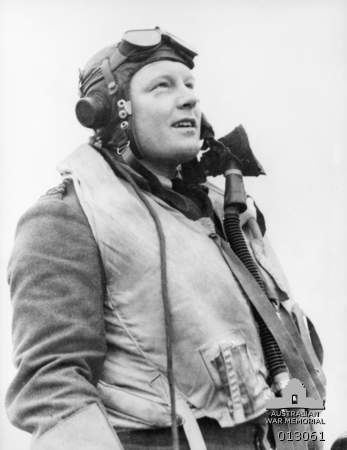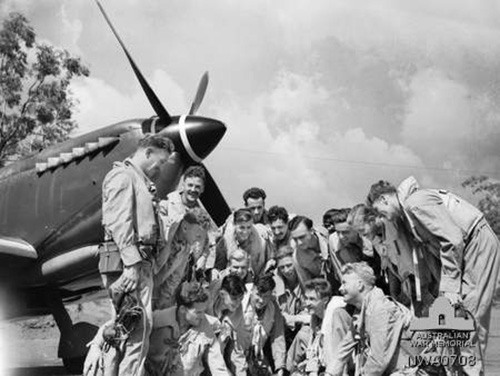Truscott, Keith William "Bluey"
- Date of birth:
- May 17th, 1916 (Prahan/Victoria, Australia)
- Date of death:
- March 28th, 1943
- Buried on:
- Commonwealth War Cemetery Perth
Plot: H. Row: A. Grave: 12. - Service number:
- 211025/Aus.400213
- Nationality:
- Australian
Biography
Truscott was educated at Melbourne High School after which he worked some time as a clerk. He was a good football player and played for the Melbourne Football Club which brought him fame.
He enlisted in the Royal Australian Air Force on 21 July 1940 but struggled with flying lessons.
His flying program continued though in Canada after which he was commissioned in February 1941 and sent to England where he joined No.452 Squadron in May. Flying Spitfires, he took part in offensive patrols and escorted bombers. In January 1942 he became Commanding Officer of 452 Squadron.
He was rested in May 1942 and returned to Australia after which he was posted at No. 76 Squadron in the Pacific, flying in Kittyhawks. From Papua No. 76 and 75 Squadron played a decisive role in driving back the Japanese who had landed at Milne Bay.
On 27 August, when No.76 Squadron's commanding officer was killed at a critical stage of the battle, Truscott took command.
During a period of routine flying, on 28 March 1943, while carrying out mock attacks over Exmouth Gulf, Western Australia, he misjudged his height, struck the water and was killed.
Do you have more information about this person? Inform us!
- Period:
- Second World War (1939-1945)
- Rank:
- Pilot Officer
- Unit:
- No. 452 Squadron, Royal Australian Air Force
- Awarded on:
- October 17th, 1941
"This officer joined the squadron in May,1941, after a period of training in Australia and Canada. He has participated in many operational sorties against the enemy and has displayed great courage and determination throughout. Pilot Officer Truscott has destroyed at least 6 enemy aircraft."
- Period:
- Second World War (1939-1945)
- Rank:
- Acting Squadron Leader
- Unit:
- No. 452 Squadron, Royal Australian Air Force
- Awarded on:
- March 27th, 1942
"This officer is a skilful and courageous fighter pilot. Since May, 1941, he has participated in a large number of sorties and convoy escorts. Throughout, he has shown a fine fighting spirit and, in combat, he has destroyed 11, probably destroyed 3 and damaged a further 2 hostile aircraft. One day in February, 1942, Squadron Leader Truscott participated in an attack on an enemy destroyer which was left in a damaged condition with black smoke issuing from behind the bridge. The next day, he assisted in the destruction of a German floatplane."
Second DFC awarded as a bar for on the ribbon of the first DFC.
- Period:
- Second World War (1939-1945)
- Rank:
- Squadron Leader
- Awarded on:
- March 26th, 1943
- Period:
- Second World War (1939-1945)
- Period:
- Second World War (1939-1945)
- Period:
- Second World War (1939-1945)
- Period:
- Second World War (1939-1945)
- Period:
- Second World War (1939-1945)
- Period:
- Second World War (1939-1945)
Sources
- Photo 1:
- Photo: Australian War Memorial
- - SHORES, CH. & WILLIAMS, C., Aces High, Grub Street, London, 1994.
- Third Supplement to The London Gazette Issue 35312 published on the 14 October 1941
- Third Supplement to The London Gazette Issue 35954 published on the 23 March 1943
- Fourth Supplement to The London Gazette Issue 35502 published on the 24 March 1942
- Australian Dictionary of Bopgraphy











